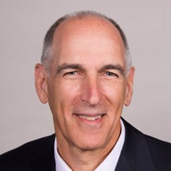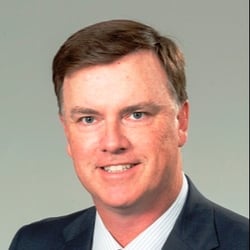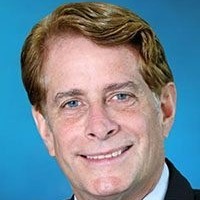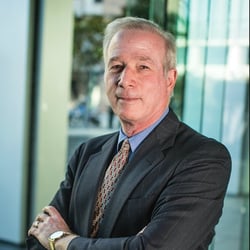 Craig Samitt, MD, MBA is the EVP and Chief Clinical Officer at Anthem, where he is responsible for establishing, leading, and executing overall clinical vision and strategy for Anthem, the second largest health insurer in the US. In this role, Craig leads all clinical operations and policy as well as Anthem’s diversification strategy, from payer as a benefit-management company to payer as partner, enabler, and convener. An internal medicine physician by training, Craig has worked across multiple sectors within the health ecosystem including providers, payers, and policy makers. His work specializes in turnaround management, growth of physician networks, enhancing integrated delivery systems, and diversifying health plans in competitive markets.
Craig Samitt, MD, MBA is the EVP and Chief Clinical Officer at Anthem, where he is responsible for establishing, leading, and executing overall clinical vision and strategy for Anthem, the second largest health insurer in the US. In this role, Craig leads all clinical operations and policy as well as Anthem’s diversification strategy, from payer as a benefit-management company to payer as partner, enabler, and convener. An internal medicine physician by training, Craig has worked across multiple sectors within the health ecosystem including providers, payers, and policy makers. His work specializes in turnaround management, growth of physician networks, enhancing integrated delivery systems, and diversifying health plans in competitive markets.
Key Takeaways
- All the players in the health ecosystem have done what they can within their world, but the industry now needs a new model that coordinates across the various players.
- Collaboration requires an understanding of each stakeholders’ expertise and capabilities to maximize the strength of the partnership.
- The health ecosystem requires engagement of non-traditional players to address the social determinants of care by influencing “upstream” stakeholders.
TLD Group: What is Anthem’s role in the health ecosystem?
Samitt: I would define our role in the health ecosystem as immersed and evolving. Immersed because of how interconnected we are with many of the key players in the ecosystem, specifically members, health plans, patients, employers, providers, other payers (e.g. the government), and vendors that are innovating and creating new solutions to impact the health of the communities served by our health plan affiliates. Our role in connecting these various players, positions us to help the collective ecosystem design innovative solutions and move forward. Evolving because I believe organizations, like Anthem, have not yet capitalized on their immersion in the ecosystem to drive significant and necessary change. Payers have historically functioned in the realm of benefits management, yet there’s a great opportunity for payers to play a more significant role – e.g. payer as analytics company, retail company, navigator, facilitator, convener, enabler, and other positions that leverage its ability to drive change.
TLD Group: What is the imperative for payers to change their business model and adopt a new way of doing things?
Samitt: All players in the ecosystem share the goal of providing higher quality, more accessible, more affordable care to the people we serve. Everyone talks about that as an aspiration, but there are very few organizations that have executed upon it, because execution of the Triple Aim to some extent requires reinvention of each of the players. It feels that all the distinct players in the ecosystem have done what they can do within their world to drive industry change. Payers have used their historical benefits management tools to maximize quality and reduce costs. Providers have sought to improve quality and value, but with limited access to capital and tools to help move to the next level. Unless we begin to see partnerships with shared accountability and coordination of functions across the various players, we’re not going to advance to the next level. It’s time for a new model. Secondly, things have gotten very complex, and there is an absence of an entity that has “stepped up” to bring order out of chaos. As things become more complex, there’s a greater need for order. I think now is the time for us to step forward with a new set of solutions.
TLD Group: How has Anthem succeeded in changing its business model?
Samitt: One of our many growing payer/provider relationships is Vivity, which is a product offered by our California health plan in partnership with seven of the largest and most successful health systems in Southern California. The collaborators recognized that a delivery system that is exceptional in achieving high-quality outcomes could partner with a payer that is interested in quality, cost, and service, and bring their expertise together to work in alignment for the benefit of the patients and the members. The team that’s leading this partnership, newly-founded within Anthem, developed new approaches to effectively support both the payer and the providers. For example, the analytics that support population health needed to be provider-user-friendly and provider-workflow-embedded. As opposed to a claims-oriented system, we needed a system that merged claims and clinical data into an existing platform that various providers could use. We evolved our analytics approach and the systems that providers use to blend clinical and claims information into a usable format. As another example, payers have historically used telephonic case management as their approach to manage complex patients, but in the provider world you really want practice-embedded case management that’s co-located with the caregivers. We’ve got a team of provider-enablement clinicians that position themselves within hospitals and within practices, to work directly with the caregivers as opposed to working virtually. We’re early into this partnership, but are beginning to see great results, including the evolution of quality outcomes, safety improvement, and cost reduction that show significant progress from the collective organization’s prior performance.
TLD Group: How do you engage other organizations to work with Anthem to drive collaborative solutions?
Samitt: The need for payer/provider collaborations and provider-enablement stemmed from Anthem’s progress toward value-based payments. We were one of the first payers to aggressively pursue transition from fee-for-service to value-based payment and ACOs. We realized that we would not be able to drive value if we did not play a more substantive role in assuring that providers knew how to reinvent themselves in a value-based world. One of the reasons why managed care failed in the past was that payers did not play a central role, and in some instances neither the payer nor the provider had the effective tools to thrive under value-based arrangements. Our desire was to avoid repeating the past by developing a set of capabilities that supported providers as they entered into value-based arrangements with Anthem, specifically the embedding of care management and practice transformation supports within the practice. Our goal was to offer providers the tools and services that we know work in the industry and embed them in their practice resources to help assure their success.
Anthem’s toolkit of resources and services includes about 12 transformational dimensions. Not every provider is in the same place in terms of capabilities. The discussions often start out with both sides comparing and contrasting their capabilities and services to inform decisions. Oftentimes, the provider and payer want to retain ownership of the capabilities they do well. By comparing the strengths and weaknesses on these 12 dimensions, we can determine which areas each excels at, and negotiate through the gray areas. Negotiating in this way helps overcome “turf wars” in which each want to retain ownership of everything they’ve done, rather than trusting that the other has better expertise or resources to do a better job.
However, not every health system is at the same level of receptivity to redesign a practice. There are many organizations that have not bought into value-based transformation, and they are very likely to turn down our services. That said, there’s great receptivity by others that are more advanced in their thinking and understand that value-based transformation is inevitable. Anthem doesn’t need every provider in our market to pursue value, but rather just a significant provider who is willing to take a leap of faith and collaborate to build something new together. We just need a frontrunner in every market to set the pace, who will likely then drive change in the whole market.
TLD Group: What is your perspective on engaging non-traditional collaborations in Anthem’s health ecosystem?
Samitt: Social determinants of health are the greatest driver of healthcare costs. I believe that the industry needs to be reinvented to develop “upstream thinking,” which is the prevention of sickness, illness, accidents, and other health issues by influencing patients and their network of relationships to be accountable for their own health. The question becomes, how do we influence the “upstream” stakeholders (i.e. points of prevention) to control health so that we don’t have to rely on the “downstream” stakeholders (e.g. hospitals, doctors, etc.) to treat sickness? We, as healthcare organizations, need to invest a portion of our time and energy educating families, employers, and communities, to all play a role in influencing sickness prevention and health awareness by providing them with the tools, resources, and incentives to manage health. We need to find a way to get consumers to be accountable for their own health, and find a way to support providers to focus on more value-based rather than volume-based approaches to care. We can collaborate with public health and community organizations to influence social determinants. The difficulties in forging these relationships are 1) the financing divide that exists between public health and medical health, and 2) the ability to deploy payer resources from the health sector to the social sector. I’m not sure we’ve developed the right approach to bridging that divide, but organizations like Anthem are well-positioned to work with the public sector to figure that out. Right now, we’re early on in having those conversations and are trying to understand how we can connect our two worlds. I believe that’s where we’ll start to see more innovation.
View our other HELM Q&A Interviews:

 Craig Samitt, MD, MBA is the EVP and Chief Clinical Officer at Anthem, where he is responsible for establishing, leading, and executing overall clinical vision and strategy for Anthem, the second largest health insurer in the US. In this role, Craig leads all clinical operations and policy as well as Anthem’s diversification strategy, from payer as a benefit-management company to payer as partner, enabler, and convener. An internal medicine physician by training, Craig has worked across multiple sectors within the health ecosystem including providers, payers, and policy makers. His work specializes in turnaround management, growth of physician networks, enhancing integrated delivery systems, and diversifying health plans in competitive markets.
Craig Samitt, MD, MBA is the EVP and Chief Clinical Officer at Anthem, where he is responsible for establishing, leading, and executing overall clinical vision and strategy for Anthem, the second largest health insurer in the US. In this role, Craig leads all clinical operations and policy as well as Anthem’s diversification strategy, from payer as a benefit-management company to payer as partner, enabler, and convener. An internal medicine physician by training, Craig has worked across multiple sectors within the health ecosystem including providers, payers, and policy makers. His work specializes in turnaround management, growth of physician networks, enhancing integrated delivery systems, and diversifying health plans in competitive markets.



 Andrew Baskin, MD, is Aetna’s Vice President, National MedicalDirector for Quality and Clinical Policy and served as the Interim Chief Medical Officer (in 2014). He works on initiatives to measure and improve quality of care, the provision of evidence based care, quality measurement implementation and public reporting, health plan accreditation, and the establishment of performance based networks. Additionally, Andy partners with others to help establish programs which create incentives for more effective and efficient care, influence and assure compliance with healthcare reform regulations, develop products to improve affordability and quality of care, and promote payment reform.
Andrew Baskin, MD, is Aetna’s Vice President, National MedicalDirector for Quality and Clinical Policy and served as the Interim Chief Medical Officer (in 2014). He works on initiatives to measure and improve quality of care, the provision of evidence based care, quality measurement implementation and public reporting, health plan accreditation, and the establishment of performance based networks. Additionally, Andy partners with others to help establish programs which create incentives for more effective and efficient care, influence and assure compliance with healthcare reform regulations, develop products to improve affordability and quality of care, and promote payment reform. Mohamed Diab, MD, Vice President of Provider Transformation leads population health management at Aetna. His focus is on providers as they transform their care delivery to achieve the “Triple Aim” by improving quality of care and reducing unnecessary cost. Mohamed has more than 25 years of experience as a provider as well as an executive in the payer and consulting industries. He has a background in medical management, pharmacy benefit management, clinical informatics and cost management programs.
Mohamed Diab, MD, Vice President of Provider Transformation leads population health management at Aetna. His focus is on providers as they transform their care delivery to achieve the “Triple Aim” by improving quality of care and reducing unnecessary cost. Mohamed has more than 25 years of experience as a provider as well as an executive in the payer and consulting industries. He has a background in medical management, pharmacy benefit management, clinical informatics and cost management programs.







 Robert C. Garrett is Co-CEO of Hackensack Meridian Health, which has four hospitals ranked among the top 10 in New Jersey according to U.S. News & World Report – including No. 1 ranked Hackensack University Medical Center - more than any other network in the state. Robert focused on aggressive expansion of the Hackensack University Network before its merger with Meridian Health. As Co-CEO, Robert concentrates on innovation and leading partnerships, including launching New Jersey’s first private medical school with Seton Hall University and a historic partnership with Memorial Sloan Kettering Cancer Center.
Robert C. Garrett is Co-CEO of Hackensack Meridian Health, which has four hospitals ranked among the top 10 in New Jersey according to U.S. News & World Report – including No. 1 ranked Hackensack University Medical Center - more than any other network in the state. Robert focused on aggressive expansion of the Hackensack University Network before its merger with Meridian Health. As Co-CEO, Robert concentrates on innovation and leading partnerships, including launching New Jersey’s first private medical school with Seton Hall University and a historic partnership with Memorial Sloan Kettering Cancer Center. John K. Lloyd is Co-CEO of Hackensack Meridian Health, one of the largest, most comprehensive health networks in New Jersey, which includes 13 hospitals, 28,000 team members, more than 6,000 physicians and over 140 patient care locations across the state. John has focused much of his career on developing a full continuum of care – long before national health care reform mandated such changes. As Co-CEO, John oversees all non-acute care hospital businesses, including population health and the foundations. John’s expertise and vision have helped the network meet and exceed the challenges of health care reform.
John K. Lloyd is Co-CEO of Hackensack Meridian Health, one of the largest, most comprehensive health networks in New Jersey, which includes 13 hospitals, 28,000 team members, more than 6,000 physicians and over 140 patient care locations across the state. John has focused much of his career on developing a full continuum of care – long before national health care reform mandated such changes. As Co-CEO, John oversees all non-acute care hospital businesses, including population health and the foundations. John’s expertise and vision have helped the network meet and exceed the challenges of health care reform. Patrick R. Young is president of Population Health for Hackensack Meridian Health, where he leads the Population Health division and is responsible for accelerating the development of strategic priorities related to health care reform; population health management; Meridian’s Medicare Shared Savings Accountable Care Organization; Hackensack Meridian Health Partners, Hackensack Meridian Health’s clinically integrated network; health insurance partnerships; as well as overseeing Managed Care.
Patrick R. Young is president of Population Health for Hackensack Meridian Health, where he leads the Population Health division and is responsible for accelerating the development of strategic priorities related to health care reform; population health management; Meridian’s Medicare Shared Savings Accountable Care Organization; Hackensack Meridian Health Partners, Hackensack Meridian Health’s clinically integrated network; health insurance partnerships; as well as overseeing Managed Care.































































